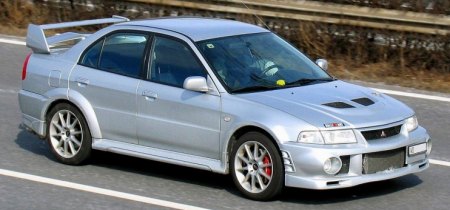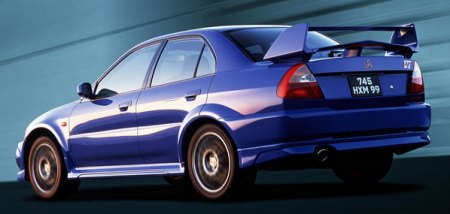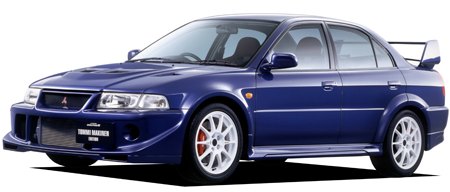Yet another special edition Evolution VI was released in 1999: the Tommi Mäkinen Edition, named after Finnish rally driver Tommi Mäkinen that had won Mitsubishi four WRC drivers championships. It featured a different front bumper, Red/Black Recaro seats (with embossed T. Mäkinen logo), 17" Enkei white wheels, a leather Momo steering wheel and shift knob, a titanium turbine that spooled up more quickly, front upper strut brace, lowered ride height (with tarmac stages in mind), and a quicker steering ratio. Amongst other colours, the Evo VI came in either red (Tommi Mäkinen Edition only), white, blue, black or silver with optional special decals, replicating Tommi Mäkinen's rally car's colour scheme. This car is also sometimes referred to as an Evolution 6½, Evolution 6.5, or TME for short


| Overview | |
|---|---|
| Production | January 1999 – March 2001 |
| Body and chassis | |
| Platform | CP9A |
| Powertrain | |
| Transmission | 5-speed manual |
| Dimensions | |
| Wheelbase | 2,510 mm (98.8 in) |
| Length | 4,350 mm (171.3 in) |
| Width | 1,770 mm (69.7 in) |
| Height | 1,405–1,415 mm (55.3–55.7 in) |
| Curb weight | 1,260–1,360 kg (2,778–2,998 lb) |

Evo VI (1999)
Janurary 1999 came Evo VI.
In this generation the improvement concentrated on aerodynamics as a
response to the changes made to WRC regulations. In particular, the
rear wing became bi-plane. Engine cooling was also enhanced, making the
same power and torque more durable. RS model introduced the world's
first titanium turbine to reduce turbo lag. Besides, the chassis got
extra spot welds to increase rigidity while the suspension got some
detailed modifications. The Evo VI was probably no faster than its
predecessor, but it was undoubtedly more competitive in rally stages.
It brought Makinen the fourth consecutive WRC driver's title, also the
last time for the Mitsubishi rally team. Since the championship shifted
from Group A production cars to more specialized WRC-spec machines, the
Lancer Evolution series had lost its advantage.

While all previous Evos were bounded in Japan, a small batch of Evo VI was officially exported to the UK. When Autocar road tested it in 1999, it recorded some very exciting performance figures: 0-60 in 4.4 sec and 0-100 in 11.2 sec. It praised the car for not only lightning speed but also first-rate braking, immense traction and grip and eye-widening handling. It described the car "feels more like a fighter aircraft than it does a humble automobile in the way it slices into bends, and then sucks itself to the floor, seeming to defy the laws of physics as it goes". The only complaints were the stiff low-speed ride and a steering that was not as feelsome as a focused driver's car should. As for conclusion, the magazine said "This is a car which can swallow four adults and their luggage as effectively as any Ford Mondeo, yet one which can level with all but the fastest Ferraris in a straight line. A car that's as refined as a Nissan Primera on the motorway yet one that can out-corner and out-brake any product currently made by Lotus. Yet it's also a car that costs no more than a well specified, non M-badged BMW 3-series."
As the Evo VI was lighter and actually faster than the subsequent Evos, it was widely regarded as the best of the breed.

While all previous Evos were bounded in Japan, a small batch of Evo VI was officially exported to the UK. When Autocar road tested it in 1999, it recorded some very exciting performance figures: 0-60 in 4.4 sec and 0-100 in 11.2 sec. It praised the car for not only lightning speed but also first-rate braking, immense traction and grip and eye-widening handling. It described the car "feels more like a fighter aircraft than it does a humble automobile in the way it slices into bends, and then sucks itself to the floor, seeming to defy the laws of physics as it goes". The only complaints were the stiff low-speed ride and a steering that was not as feelsome as a focused driver's car should. As for conclusion, the magazine said "This is a car which can swallow four adults and their luggage as effectively as any Ford Mondeo, yet one which can level with all but the fastest Ferraris in a straight line. A car that's as refined as a Nissan Primera on the motorway yet one that can out-corner and out-brake any product currently made by Lotus. Yet it's also a car that costs no more than a well specified, non M-badged BMW 3-series."
As the Evo VI was lighter and actually faster than the subsequent Evos, it was widely regarded as the best of the breed.

Evo VI Tommi Makinen edition
Jan 2000 introduced Tommi Makinen edition of Evo VI as a
celebration to the driver's 4th consecutive WRC title with Mitsubishi.
Cosmetic changes aside, there were some minor tweaks – the ride height
was dropped 10mm (hence an even harsher ride), revised titanium turbine
to improve low-end response, more engine cooling, larger-diameter
exhaust and improved oil pan. A new air dam improved aerodynamics and
engine cooling. The Makinen edition was usually referred to Evo 6.5.
Hardcore drivers saw it as the best of the best.
a
No comments:
Post a Comment